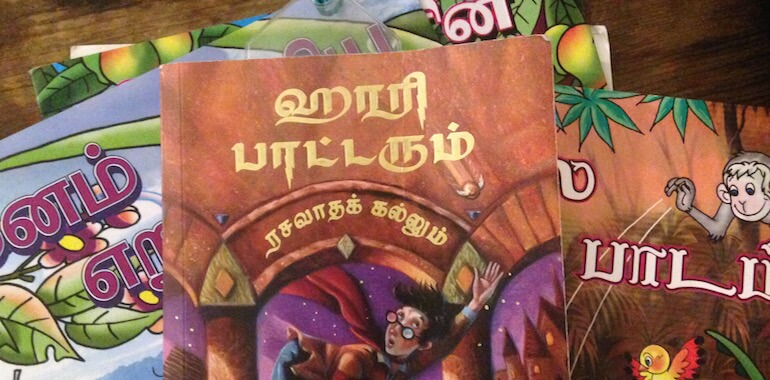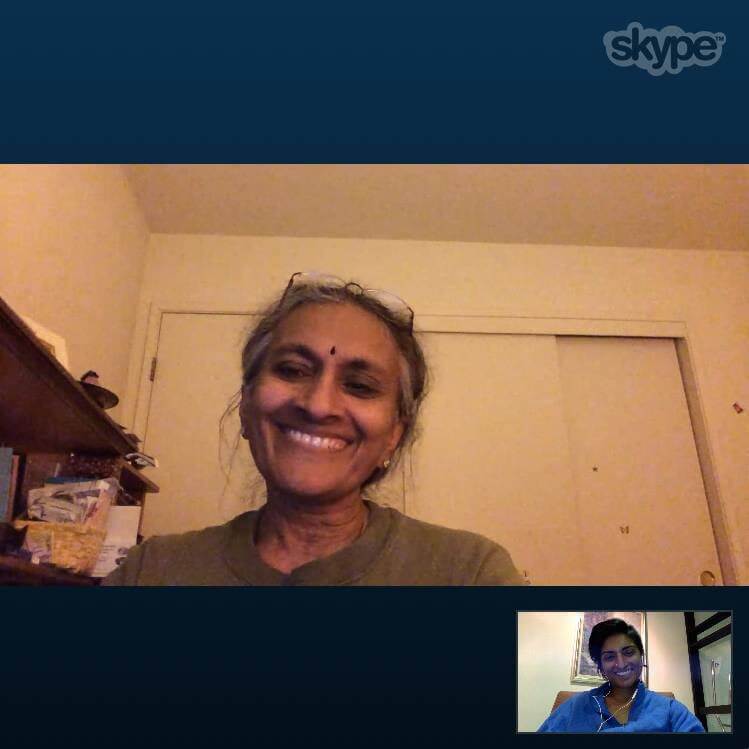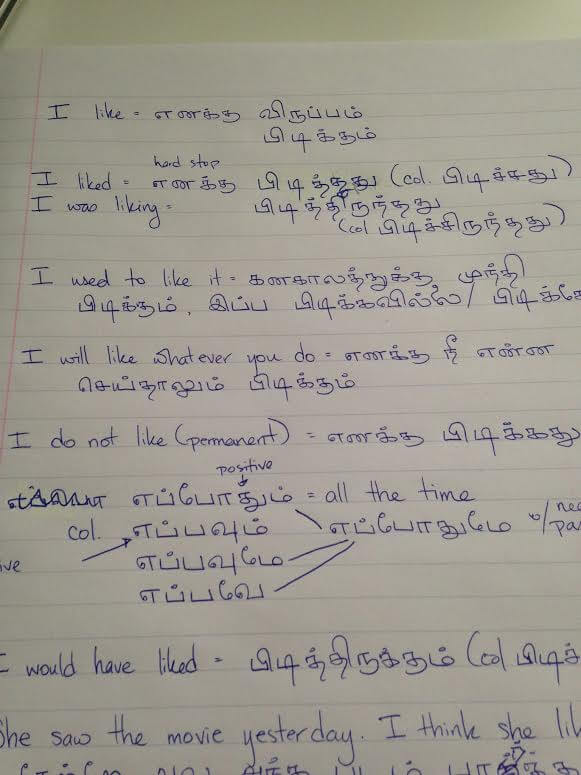
Like many first generation diaspora Tamils, I grew up not really speaking Tamil. I spent the majority of my college years and early adulthood chastising my parents for not having taught me when I was young. Being an adult made it much harder to learn a language. Being an adult also made me responsible for my life choices. I wanted to speak Tamil.
When I first began learning Tamil, I could not maintain a conversation longer than two minutes. I can now tell stories about my day, navigate travel in Tamil speaking countries by myself, and express opinions on medium-weight topics. The following are what helped me learn Tamil.
1. Get rid of all shame and embarrassment
I reached an emotional tipping point where I NEEDED to know Tamil. At that point, I decided feelings of shame or embarrassment had no place in my life. I will speak Tamil anywhere I can, with anyone I can. I make mistakes all the time. I get laughed at. When that happens, I take note of what I was trying to say when the person laughed. Later I will ask my Amma what I said wrong. If the person is a friend, I ask them directly.
2. Make time to learn
I read an article many years ago about how we make time for things that matter. It changed my life. I don’t have time to learn Tamil; I make time to learn Tamil.
There was a point where I was taking three classes a week: one hour Skype with my Amma, one hour Skype with a teacher in Toronto, and one hour in person at the local Indian Tamil Sunday school* (my peers were 8 and 9 year olds).
This morning, I put in 20 minutes of learning online. Later I’ll do some reading, and tonight I’ll probably watch a Tamil film. On days that are busier, I might text a few friends in Tamil and use a learning app for 2 minutes while I’m on the toilet. I give myself no excuses. If I want to make time, I will.
It was very important to me that my Tamil sound like Ilankai Tamil. With that said, I found the Indian Tamil school very helpful for my grammar. Grammar is the same everywhere.

3. Combine interests
I love plants. When I started learning Spanish, I got a job at a gardening store where everyone spoke Spanish. I found that combining interests increased my internal motivation to learn. I don’t know any Tamil gardening stores, so instead I like to watch and read stories I already know in English that have been translated into Tamil. Knowing the plot makes it easier to pick up on what’s being said, plus I am able to laugh and enjoy.
Currently, I am watching “Rush Hour” (available on YouTube) and reading Harry Potter (available on Amazon). Learning songs is also a fun way to go.
4. On reading and writing
I am not a purist. The point of a language is to connect and to communicate. You don’t need to read in order to be able to do this. With that said, I chose to learn reading and writing for a few reasons.
- Tamil, unlike English, is pronounced exactly as it is spelled. I wanted to pronounce things properly. For that I needed to be able to read.
- We are a people of writers. Whether it’s Uthayan or Ponniyin Selvan, I wanted access to our stories and this part of our culture.
- Themed reading is a great way to learn, because vocabulary repeats. When I started, I put my focus on politics in the East and North of Sri Lanka, reading short online news articles. Very quickly, I began to pick up key words (அரசாங்கம்/government, பாராளுமன்றம்/parliament, ஐக்கிய நாடுகள் சபை/United Nations). I was then able to incorporate these words into my spoken vocabulary.
- Many people feel frightened or overwhelmed by reading, but the truth is reading is largely word recognition. How many of these words are you actually sounding out right now? My guess is none. Because the words I’m using are all very common words, you’re most likely scanning and recognizing. I have found that as my vocabulary expands, my reading gets faster. I learn new words while reading, so my speaking improves. It’s a positive feedback loop.
5. Learn your learning style
I am a tactile-visual learner. I do best if I can see what I’m learning and also if I can involve my body. Writing things out works for me (with a pen and paper, not computer). In person conversations are best. Then Skype, then phone. I don’t always have access to the resource that works best for me (Amma and I live 300 miles apart, so our classes are on Skype), but it’s helpful for me to know.
I am not a student who can study for hours on end. I do best with diversity in my learning. I often combine my Tamil studies with other work. I will do maybe 20 minutes of one of my Tamil online courses (focused attention). Then I’ll practice a Tamil song I’m trying to learn (playful learning). Then I might work on a piece of writing which has nothing to do with Tamil (creative/mental stimulation). Then I'll take a 7 minute dance break (physical release). Like that, I’ll go back and forth between activities to optimize my energy and attention.

6. Take control of your classes
All of the teachers I’ve had are native Tamil speakers – a great resource. None of them have had any actual training on how to teach a language. When I first started taking classes, I would feel overwhelmed and confused by their teaching styles – which was frustrating, because at the time, I was paying for classes.
It’s been my responsibility to understand how I need my classes to be set up and to then train my teachers to teach me in a way that matches my learning style. I know that I learn best with a tangible structure and repetition. Here are some things I’ve done with my Amma in the past few months:
- I made a list of every type of verb conjugation I could think of in English (for example, I go/I went/I would have gone/I will have gone/I might go, etc). Each week, I selected one verb I wanted to learn and we put the verb through this list. Not all English conjugations exist in Tamil, and some Tamil conjugations exist which do not exist in English.
- பட்டது/pattathu often gets put at the end of sentences. I understood it when it was said, but I didn’t understand how to use it. I asked my Amma to say as many sentences as she could using பட்டது/pattathu while I made a list. We then worked backwords to make sense of the pattern.
- My Amma identified that I couldn’t create phrases such as “the book I gave”, “the book that was there”, “the book I left”. She created drills for me, starting with just the phrase (the book I gave) and expanding into full sentences (Where did you put the book I gave you?). I set the limit on how many new phrases she could introduce each class. We started with 4 and each class she could introduce 1 or 2 more.
- For all things, I ask my Amma how to say things formally as well as colloquially. I do my best to learn both distinctly, so that I can use the correct one in the correct context.
7. Cry
I have cried so much in the process of learning Tamil. If your parents are anything like mine, you also were raised to set very high expectations for yourself. Often unreasonably high. Not meeting those expectations has sometimes felt like the end of the world. Add to that the emotional urgency of wanting to converse fluently with my monolingual, Tamil-speaking family, the deep-rooted desire to maintain a connection with the island, our people. I have gone through waves of feeling sad, helpless, stupid.
I am learning how to be gentle with myself. I have taken breaks from learning Tamil when it has felt too overwhelming. I always come back. I have made peace with the fact that learning this language may be a lifelong journey. I show up, I do the work, I cry, I start over.
Resources:
- Created by Sendhil Cheran, formerly learntamil/tamilclass.com: http://www.ibiblio.org/learntamil
- Penn State: http://ccat.sas.upenn.edu/plc/tamilweb/
- 101 Tamil Verbs: https://www.amazon.com/dp/1619494035/ref=rdr_ext_tmb I've not bought this book, but I'm considering it.
- Memrise is a website and also an app. They have classes in both Tamil and transliterated Tamil (Tamil written in English). My favorites are:
- You can find Tamil language films with or without subtitles on YouTube, Netflix, and my recent fave HeroTalkies.
- Italki and HelloTalk are both apps which allow you to connect with native speakers in order to do a language exchange/practice.
These are only a few. There will certainly be more. I'd love to hear about them as you find what works for you.
Related articles: Why It’s Important to Learn Tamil The Astonishing Links Between Tamil and Japanese Why Don’t Tamils Speak Tamil? What is Arwi (Arabic Tamil)?

























